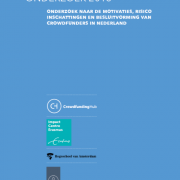Current State of Crowdfunding in UK 2016
An overview

Inhabitants: 64,72 million
GDP (ppp) per capita: $39,826
(Source: Wikipedia; Image Credit: NuclearVacuum)
Crowdfunding, in all its forms, continues to grow and thrive across the UK. As a country that embraces all the four primary models of crowdfunding, the UK has enjoyed a vibrant and innovative market for some years now and that comparative maturity is building the confidence of participants on both the demand and supply side. As the awareness of crowdfunding grows, and with that the scale of deals, so does the applicability of crowdfunding to an ever wider range of business and project type.
Volumes in 2015 (note that there is disagreement about precise totals)
- Donation based £12 million
- Reward based crowdfunding £42 million*
- P2P Business lending(£881 million excluding real estate lending.)
- P2P consumer lending £909 million
- Equity based £332 million** (£245 excluding real estate crowdfunding)
- Community shares £61 million
(Source: Pushing Boundaries, The 2015 UK Alternative Finance Industry Report, University of Cambridge)
* Crowdfunding Data Center reports £50 Million
** Altfi reports £169 Million
Local platforms
Crowdfunder.com (reward) has extended its offer to include Community Share Issues.
FundingCircle.com and Zopa.com (P2P Lending) are well established. Their continued growth is certainly in part a function of the lack of retail investment opportunities driving investors in search of returns on to the platforms. Funding Circle alone has made more £1.1 billion available to businesses from its foundation. The borrowing for business is, in most cases, to fund expansion and growth but the variety of deal financed by the crowd grows with a £1.5 Million management buyout financed by the Edinburgh based LendingCrowd being a recent example.
Crowdcube.com, Seedrs.com and SyndicateRoom.com (equity) dominate the market in terms of both value and number of deals.
Each has a distinctive model or approach and they highlight the perceived benefits of this differentiation as a key competitive advantage. Exits for investors are beginning to emerge and for the more traditionally oriented investors this will be a key factor in the perceived success of crowdfunding in the coming years.
Foreign Platforms
Kickstarter and Indiegogo have UK presence.
Regulations
The UK crowdfunding sector is subject to specific regulation in the equity and P2P lending field. The regulatory body is the Financial Conduct Authority (FCA), which introduced a wholly new set of regulations for the P2P sector in April 2014 and, at the same time, some additional requirements for equity crowdfunding platforms. Prior to this the P2P sector was not formally regulated, as it was not considered to fall under any existing regulatory regime. The regulations require that platforms operating in the sector must be authorised (Licensed) and conform to standards set out by the FCA.
The equity sector has always been regulated but additional regulations dealing specifically with crowdfunding activities were introduced also in April 2014. These will be reviewed and amended if deemed necessary. Primarily the regulations require platforms to be authorised (Licensed) or to have regulated activities managed by authorised parties, and a screening process must be in place to sort sophisticated and non-sophisticated investors. If an investor is deemed a “non sophisticated” investor constraints are placed on how much they are permitted to invest, in that they must not invest more than 10% of their net investable assets in investments sold via what are called investment-based crowdfunding platforms.
Additional regulations concern the communication of the offers, the fairness, language and clarity of description used to describe these offers and the awareness of the risk associated with them.
Whilst most offerings are small enough to take advantage of the exemptions offered by the EU Prospectus Directive there are examples where crowdfunding activities have been conducted with properly prepared prospectuses thereby permitting higher raises to be transacted, notably the Brewdog Equity For Punks IV offer.
Whilst often viewed as a good regulatory regime there are those that contend that they are founded in an old world understanding of finance and motivation and so are not sensitive to the distinctiveness of crowdfunding models and philosophy. Survey data suggests that most platforms are reasonably comfortable with these arrangements however, as the intention is to protect the consumer from inappropriate behavior by platforms and those they permit onto them, this metric of acceptability to platforms may not be a good indicator of the efficacy appropriateness of the existing regulatory framework.
Banks & Government
Set against a period of continued subdued demand from business for bank finance it is apparent that crowdfunding is beginning to be seen as an important source of finance to business. The UK government is introducing requirements for banks to be obliged to offer alternative finance options to clients to whom they refuse loans. This is likely to increase pressure on banks to engage more fully with the sector. It is worth noting that in a survey of 200 international delegates attending the University of Edinburgh Business School’s Credit Risk and Credit Control conference three-quarters felt alternative lenders now pose a threat to banks and traditional lenders. There is some way to go before this happens but even Ian McCafferty, External Member of the Monetary Policy Committee of the Bank of England acknowledges, “we may well be seeing the early stages of some important changes to the architecture of business finance.”
The generally positive stance toward crowdfunding from the UK Government is also helpful to the sector. This encouragement can be seen through the Government’s use of the British Business Bank to place funds on to a number of alternative finance platforms, the maintenance of the SEIS and EIS tax incentive scheme for investors in startups, and with introduction of the new P2P ISA provisions.
Our expert

“With such extraordinary rates of growth crowdfunding must be careful to retain its soul and distinctiveness”
The Current State of Crowdfunding in the United Kingdom is made possible by the contribution of Tim Wright
What is the potential of crowdfunding in your country?
Some notable trends are the rapidly increasing flow of institutional funds on to crowdlending platforms in particular. This manifests itself in a number of ways not least the increasing number of single lender loans that can be found in the loan books of major lending platforms. In keeping with global trends the rapid emergence of real estate funding via crowdfunding is common in the UK and seems set to continue to develop.
In terms of the trends for platforms in the UK, the regulatory environment appears to have begun to fulfil an unspoken agenda of some of the actors arguing for it. That is to say that it is beginning to act as a barrier to entry for new platforms as the cost of compliance rises and the number of new platforms tailed down for first time in 2015. It is now increasingly common to find authorised and regulated platforms in the Equity and Lending space beginning to offer the authorisation as an asset to be licensed by third parties.
What are the biggest challenges?
The main challenges include:
Transparency – as the market becomes more complex and crowded the competitiveness between platforms is making it harder to accurately report performance and activity levels. Without valid and sensible comparative data it is difficult for participants to make sound judgements and for civic and governmental bodies to act and respond in the most appropriate manner.
Risk – As time passes the attrition rate on entrepreneurial start ups will inevitably begin to take effect, with the rising failure rate of some businesses which have been funded in part by crowdfunding being portrayed as a failing specific or unique to crowdfunding or of uniquely high risk to “novice investors”. Already some lurid stories have emerged which have sensationalised some failures, and this is not merely in the equity realm but includes the reward sector as well. The awareness of investors and backers of risk and how to mitigate it in a manner appropriate for crowdfunding needs to be continuously reviewed. Unfortunately current regulations do not necessarily effectively do this.
Distinctiveness – The increasing involvement of the established capital markets in the alternative finance and crowdfunding sector has the risk of eroding the distinctiveness of the sector and making it simply another arm of an established and privileged market. Apart from such an outcome, should it occur, being a betrayal of the promise of opportunity, inclusivity and equity that crowdfunding offers it runs the potentially greater risk of reducing the distinctive nature of the funding that crowdfunding can provide and, in so doing, reducing the value to the investee.
What is the future holding for the UK?
The future has a great deal of promise for the UK crowdfunding industry if it continues to grow while retaining its ability to be distinctive and addressing area that the market has historically underserved. It has the potential to change the business finance sector from its traditional dominance of bank finance, to bring a wider participation in the funding of business and society with the potential for more equitable outcomes, and its ability to underpin a vibrant entrepreneurial business environment is a promising one. But, to do this, a more integrated ecosystem needs to emerge where the distinctive advantages of crowdfunding as an approach to drive innovation and not solely a source of finance are more widely understood.








